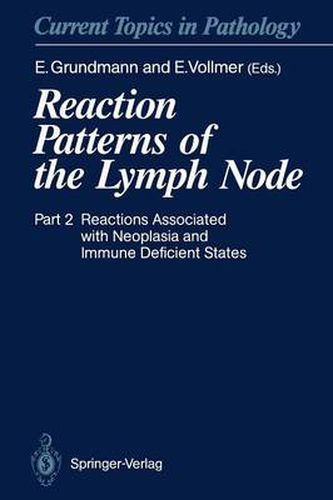Readings Newsletter
Become a Readings Member to make your shopping experience even easier.
Sign in or sign up for free!
You’re not far away from qualifying for FREE standard shipping within Australia
You’ve qualified for FREE standard shipping within Australia
The cart is loading…






This title is printed to order. This book may have been self-published. If so, we cannot guarantee the quality of the content. In the main most books will have gone through the editing process however some may not. We therefore suggest that you be aware of this before ordering this book. If in doubt check either the author or publisher’s details as we are unable to accept any returns unless they are faulty. Please contact us if you have any questions.
This second volume reports on the reaction patterns of lymph nodes in neoplastic and immunodeficient diseases. Based on the contents of volume 1, it presents a detailed survey of lymph node structures and their cellular components under these conditions. The patterns of nodal reactions to the development and spread of cancer have recently been investigated and discussed by several authors. Here, the immediate interactions between tumor tissue and the regional nodes have been assessed in experimental models and in human material. Using modern morphological methods such as im munohistochemistry on the light and electron microscopic level, new insights have been gained into the stepwise process of lymphogenous metastasis. Macrophages/reticulum cells were found to playa signifi cant role in this process, which is duly emphasized. Based on appro priate animal models, one chapter focuses on various subtypes of these cellular elements and their role in the two separate phases of tumor spread and the development of true metastases. The induction of fibronectin in lymph nodes is effected by tumor cells forming a special part of the extracellular matrix. The multifunctional fibronec tin molecule serves as a mediator between tumor cells and fibroblasts, furthering the formation of tumor stroma. This volume also contains a comprehensive survey of primary im munodeficiency syndromes and their nodal manifestations, reference being made to the most recent immunological knowledge.
$9.00 standard shipping within Australia
FREE standard shipping within Australia for orders over $100.00
Express & International shipping calculated at checkout
This title is printed to order. This book may have been self-published. If so, we cannot guarantee the quality of the content. In the main most books will have gone through the editing process however some may not. We therefore suggest that you be aware of this before ordering this book. If in doubt check either the author or publisher’s details as we are unable to accept any returns unless they are faulty. Please contact us if you have any questions.
This second volume reports on the reaction patterns of lymph nodes in neoplastic and immunodeficient diseases. Based on the contents of volume 1, it presents a detailed survey of lymph node structures and their cellular components under these conditions. The patterns of nodal reactions to the development and spread of cancer have recently been investigated and discussed by several authors. Here, the immediate interactions between tumor tissue and the regional nodes have been assessed in experimental models and in human material. Using modern morphological methods such as im munohistochemistry on the light and electron microscopic level, new insights have been gained into the stepwise process of lymphogenous metastasis. Macrophages/reticulum cells were found to playa signifi cant role in this process, which is duly emphasized. Based on appro priate animal models, one chapter focuses on various subtypes of these cellular elements and their role in the two separate phases of tumor spread and the development of true metastases. The induction of fibronectin in lymph nodes is effected by tumor cells forming a special part of the extracellular matrix. The multifunctional fibronec tin molecule serves as a mediator between tumor cells and fibroblasts, furthering the formation of tumor stroma. This volume also contains a comprehensive survey of primary im munodeficiency syndromes and their nodal manifestations, reference being made to the most recent immunological knowledge.